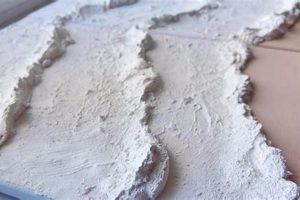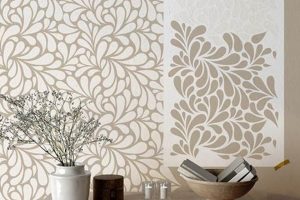A constructed interior or exterior surface designed to replicate the appearance of natural rock, often achieved through the application of manufactured materials. These materials, which can include lightweight concrete, foam, or textured panels, are applied to an existing wall to simulate the aesthetic of a genuine stone structure. For example, a living room might feature a section of wall covered in a manufactured veneer that mimics the look of stacked fieldstone.
The creation of artificial rock facades offers several advantages over using natural stone. It provides a cost-effective alternative, reducing material expenses and installation labor. Furthermore, the lighter weight of the synthetic materials simplifies handling and minimizes structural load on the building. Historically, faux finishes, including those resembling stone, have been employed to enhance the visual appeal of structures while mitigating the challenges associated with sourcing and working with authentic materials.
The subsequent sections will detail the various methods for creating this type of surface, including material selection, installation techniques, and finishing touches. These topics provide practical guidance for achieving a realistic and durable result.
Essential Considerations for Artificial Rock Facade Construction
Achieving a convincing and durable artificial rock finish requires careful planning and execution. The following considerations will guide the construction process.
Tip 1: Material Selection. Choose materials compatible with the intended environment. Exterior applications necessitate weather-resistant options, while interior installations may prioritize aesthetic considerations. Ensure the selected material’s weight is appropriate for the underlying wall structure.
Tip 2: Surface Preparation. Proper surface preparation is crucial for adhesion. Thoroughly clean the existing wall to remove dirt, debris, and loose paint. Apply a bonding agent or primer to enhance the connection between the wall and the applied materials.
Tip 3: Planning the Layout. Before installation, carefully plan the layout of the artificial rocks. Arrange the pieces on the ground to visualize the final appearance. Vary the size, shape, and color of the stones to create a more natural and random pattern.
Tip 4: Precise Cutting and Fitting. Accurate cuts are essential for a seamless appearance. Use appropriate tools, such as a wet saw or grinder, to trim the artificial rocks as needed. Ensure tight joints and minimize gaps between the stones.
Tip 5: Mortar Application. Apply mortar consistently and precisely. Avoid excessive mortar squeeze-out, which can detract from the realistic appearance. Consider using colored mortar to complement the artificial rocks and enhance the overall effect.
Tip 6: Sealing and Protection. Once the installation is complete, apply a sealant to protect the artificial rock surface from moisture and staining. Choose a sealant specifically designed for the selected material to ensure compatibility and long-term performance.
Adherence to these considerations will contribute to the creation of a visually appealing and structurally sound artificial rock facade.
The subsequent section will address common pitfalls and troubleshooting strategies associated with this process.
1. Material Selection
Material selection is a foundational element in the creation of artificial stone walls. The choice of material directly impacts the aesthetic realism, durability, and ease of installation. For example, lightweight concrete offers a substantial appearance and textural variation, mimicking natural stone formations. Its weight, however, necessitates careful consideration of the wall’s structural capacity. Conversely, polyurethane panels, while lighter and easier to manage, may require more nuanced techniques to achieve a truly convincing stone-like appearance. The selection, therefore, is a compromise between desired visual effect, installation practicality, and long-term performance.
Incorrect material choice can have detrimental effects. Using a non-weather-resistant material in an exterior application, for instance, will inevitably lead to degradation and failure due to moisture exposure and freeze-thaw cycles. Similarly, selecting a material with insufficient adhesive properties for the substrate will result in delamination and detachment over time. Projects utilizing materials poorly suited for the intended environment ultimately require costly repairs or complete replacement, underscoring the importance of informed material decisions. A project using interior-grade gypsum board on an exterior application will be a failure.
In summary, the material selection process represents a critical juncture in the overall undertaking. The decision directly dictates the outcome of the entire installation and affects its long-term viability. Thorough research and careful consideration of environmental factors, structural limitations, and aesthetic goals are necessary to ensure a successful and enduring artificial stone wall.
2. Surface Preparation
Surface preparation is inextricably linked to the success of any artificial stone wall project. The existing wall’s condition directly impacts the adhesion and longevity of the applied materials. A contaminated, unstable, or inadequately prepared surface becomes a weak point, compromising the entire artificial structure. For example, applying faux stone veneer to a wall covered in loose paint will invariably lead to detachment as the paint peels, taking the veneer with it. Similarly, grease or dust will inhibit proper bonding, resulting in sections that are prone to falling off. The underlying surface must be sound, clean, and appropriately primed to ensure a robust and lasting bond with the artificial stone materials.
Different wall types necessitate different preparation methods. Concrete walls may require patching of cracks and application of a bonding agent to promote adhesion. Drywall, on the other hand, typically benefits from a skim coat of joint compound to create a smooth, uniform surface. Wood surfaces must be assessed for rot or warping and may need to be covered with a cement backer board for increased stability and moisture resistance. Ignoring these specific requirements leads to problems such as uneven surfaces, moisture intrusion, and ultimately, a compromised artificial stone facade. A faux stone wall done in a commercial building requires inspections, permits to be done right as well.
In conclusion, proper surface preparation constitutes a non-negotiable step in any artificial stone wall project. It is the foundation upon which the entire structure rests. While it may seem like a time-consuming and tedious process, neglecting this crucial stage will inevitably lead to premature failure and costly repairs. A properly prepared surface ensures a strong, durable, and aesthetically pleasing artificial stone wall that will withstand the test of time. A good surface means it reduces costs for maintenance.
3. Adhesive Application
Adhesive application is a critical determinant in the structural integrity and aesthetic success of artificial stone wall installations. The quality and technique of adhesive use directly influence the bond between the artificial stones and the underlying substrate, impacting long-term durability and visual appeal. The following facets explore key considerations for effective adhesive application.
- Adhesive Type Selection
Selecting the appropriate adhesive is paramount. Different artificial stone materials and substrate types require specific adhesive formulations for optimal bonding. For instance, using a general-purpose construction adhesive on a non-porous surface may result in a weak bond, leading to eventual detachment. Conversely, a specialized polymer-modified mortar designed for stone veneer is often necessary for porous surfaces. The adhesive’s compatibility with both the artificial stone and the substrate, as well as its resistance to moisture and temperature fluctuations, are essential considerations.
- Surface Preparation and Priming
The surface must be properly prepared before adhesive application. A clean, dry, and stable substrate is crucial for ensuring a strong bond. Depending on the substrate, priming may be necessary to enhance adhesion. For example, applying a bonding agent to a smooth concrete wall creates a more receptive surface for the adhesive, improving its ability to grip. Inadequate surface preparation can lead to adhesive failure, regardless of the adhesive’s quality.
- Application Technique and Coverage
The adhesive must be applied according to the manufacturer’s instructions, ensuring adequate coverage and consistent thickness. Insufficient adhesive coverage results in weak spots, while excessive adhesive can create unsightly squeeze-out and hinder proper stone placement. Proper notching techniques, using a notched trowel of the appropriate size, are essential for achieving uniform adhesive distribution. Uneven application can lead to instability and an aesthetically compromised final product.
- Curing and Environmental Conditions
Adhesive curing time is a critical factor. The adhesive must be allowed to cure fully before the artificial stone wall is subjected to stress or exposure to moisture. Environmental conditions, such as temperature and humidity, can significantly affect curing time. High humidity, for example, may prolong the curing process. Prematurely loading the adhesive can weaken the bond and compromise the structural integrity of the entire installation. Following manufacturer’s recommendations for curing time and environmental conditions is essential for achieving a durable and long-lasting result.
The success of a fabricated stone wall hinges on the proper application of the adhesive. From material selection to curing, each step requires careful attention to detail. A well-executed adhesive application provides the foundation for a durable, visually appealing, and long-lasting installation, while neglecting these principles can result in costly repairs and a compromised aesthetic. The use of quality adhesive, the meticulous preparation of the area for the project and a correct application of adhesive is crucial.
4. Precise Cutting
The creation of artificial stone walls often necessitates precise cutting of the constituent materials. The accuracy of these cuts directly influences the final aesthetic and structural integrity of the installation. Irregular or poorly executed cuts result in visible seams, uneven surfaces, and a diminished illusion of authentic stonework. For example, when installing manufactured stone veneer around a window frame, accurate cuts are essential to achieve a clean, professional finish and prevent water intrusion. The materials, whether composed of concrete, foam, or polymer composites, require specific tools and techniques to ensure proper sizing and shaping. The cause-and-effect relationship between precise cutting and the overall quality of the faux stone wall is undeniable: inadequate cutting leads to a compromised appearance and potentially weakened structural elements.
The practical application of precise cutting extends beyond mere aesthetics. Accurately shaped stones facilitate proper interlocking and load distribution, particularly in stacked-stone designs. This is crucial for maintaining the structural stability of the wall, preventing shifting or collapse over time. Furthermore, precise cuts minimize waste, optimizing material usage and reducing project costs. Consider a large-scale project involving the cladding of an entire exterior wall with faux stone. In this instance, efficient cutting techniques and minimal material waste contribute significantly to the overall cost-effectiveness of the undertaking. Tools such as wet saws, angle grinders with diamond blades, and specialized scoring tools are commonly employed to achieve these precise cuts.
In summary, precise cutting is an indispensable component in the successful construction of an artificial stone wall. Its significance extends beyond aesthetic considerations, impacting structural stability, material efficiency, and overall project cost. While challenges such as material variations and intricate design patterns may arise, mastering the techniques of precise cutting is essential for achieving a realistic and durable faux stone wall. This element integrates with material selection, surface preparation, and adhesive application to form a cohesive and effective process.
5. Realistic Texture
Realistic texture is a critical element in achieving a convincing artificial stone wall. The degree to which the manufactured surface replicates the tactile and visual characteristics of natural stone directly impacts the overall success of the simulation. Without a plausible texture, even meticulously colored and shaped materials will fail to create the desired illusion of authenticity.
- Surface Topography and Relief
The three-dimensional surface of natural stone exhibits considerable variation in elevation and contour. Replicating this surface topography is crucial for achieving a realistic texture. Deep crevices, subtle undulations, and randomly distributed protrusions contribute to the natural aesthetic. For example, manufactured stone veneer often incorporates molds derived from actual stone faces to capture this inherent variability. Failure to reproduce this relief results in a flat, artificial appearance that detracts from the overall effect.
- Variations in Material Finish
Natural stone surfaces exhibit a range of finishes, from rough and porous to smooth and polished, often within the same stone. Simulating these variations in finish adds depth and complexity to the artificial texture. Techniques such as stippling, dry-brushing, and the application of textured coatings can be employed to achieve these diverse effects. For instance, applying a matte sealant to some areas of the artificial stone and a gloss sealant to others can create a subtle contrast that mimics the natural variations found in quarried stone.
- Color and Shadow Play
Texture is inherently linked to color and shadow. The interplay of light and shadow accentuates the surface irregularities, enhancing the perceived depth and realism. Artificial stone manufacturers often use multiple layers of colored pigments and stains to create a variegated appearance that mimics the natural color variations found in different types of stone. Furthermore, the application of antiquing washes and glazes can enhance the shadows within the textured surface, further accentuating its three-dimensionality.
- Integration of Natural Imperfections
Natural stone is rarely flawless. It often contains cracks, fissures, and other imperfections that contribute to its unique character. Incorporating these imperfections into the artificial texture enhances the overall realism. This can be achieved through the use of molds that replicate these natural flaws or through manual techniques such as carving or etching the surface of the manufactured stone. For example, simulating small hairline cracks with a fine-tipped tool can significantly enhance the perceived age and authenticity of the artificial stone.
The implementation of these facets, each playing a vital role, collectively contribute to the creation of a realistic texture in an artificial stone wall. The ultimate outcome of a faux stone construction hinges on a faithful replication of natural stone’s tactile and visual characteristics, achieved through a blend of meticulous technique and keen attention to detail. The subtle nuances that make natural stone visually appealing are what will define a successful installation.
Frequently Asked Questions
The following questions address common inquiries regarding the design, construction, and maintenance of artificial stone walls, providing clarity on essential aspects of this undertaking.
Question 1: What is the expected lifespan of an artificial stone wall?
The lifespan of an artificial stone wall is contingent upon several factors, including the quality of materials used, the adherence to proper installation techniques, and the prevailing environmental conditions. A properly constructed and maintained artificial stone wall can last for several decades.
Question 2: Can artificial stone be installed on any type of wall?
Artificial stone can be installed on various wall types, including concrete, drywall, and wood. However, the specific preparation methods and adhesive requirements vary depending on the substrate. Consulting manufacturer guidelines and local building codes is essential to ensure proper installation and structural integrity.
Question 3: What are the primary advantages of artificial stone over natural stone?
Artificial stone offers several advantages over natural stone, including reduced weight, lower cost, and ease of installation. Additionally, artificial stone is often more readily available and comes in a wider range of colors, textures, and shapes.
Question 4: Is artificial stone suitable for exterior applications?
Many types of artificial stone are specifically designed for exterior use and are formulated to withstand exposure to weather elements such as moisture, sunlight, and temperature fluctuations. However, it is crucial to select a material specifically rated for exterior applications to ensure long-term durability.
Question 5: What maintenance is required for an artificial stone wall?
Artificial stone walls typically require minimal maintenance. Periodic cleaning with a mild detergent and water is generally sufficient to remove dirt and debris. Sealing the surface can provide added protection against staining and water damage.
Question 6: How can the appearance of an artificial stone wall be customized?
Artificial stone offers considerable customization options. It is available in a wide range of colors, textures, and shapes, allowing for the creation of unique and personalized designs. Additionally, techniques such as dry-stacking, grouting, and the incorporation of accent pieces can further enhance the aesthetic appeal.
In summary, artificial stone walls represent a versatile and cost-effective alternative to natural stone, provided that careful planning, proper installation techniques, and appropriate material selection are employed.
The subsequent section will explore common pitfalls and troubleshooting strategies associated with artificial stone wall construction.
Concluding Remarks on Artificial Stone Wall Construction
The preceding discussion has explored the various facets of artificial stone wall construction, encompassing material selection, surface preparation, adhesive application, precise cutting, and the creation of realistic texture. Each element contributes significantly to the overall success of the project, influencing both the aesthetic appeal and the structural integrity of the final product. Achieving a convincing facsimile of natural stone requires meticulous attention to detail and a thorough understanding of the materials and techniques involved. Considerations of cost-effectiveness and long-term durability also play a key role in informed decision-making.
The construction of artificial rock facades presents a viable alternative to the use of natural stone, offering advantages in terms of weight, cost, and ease of installation. However, the long-term success of such projects hinges on adherence to established best practices and a commitment to quality craftsmanship. Failure to address critical aspects, such as proper surface preparation or the selection of appropriate adhesives, can result in premature failure and costly repairs. Further research and careful planning are warranted to ensure successful and enduring artificial stone installations.







